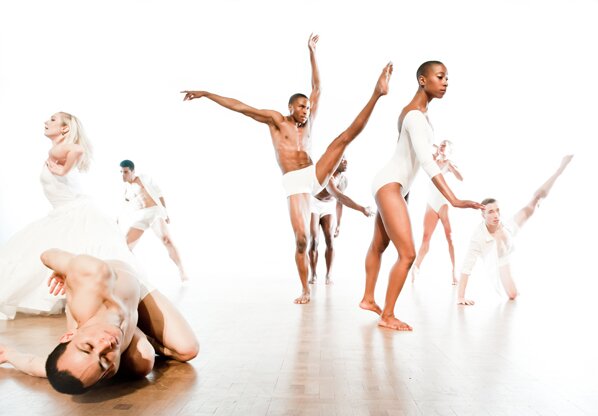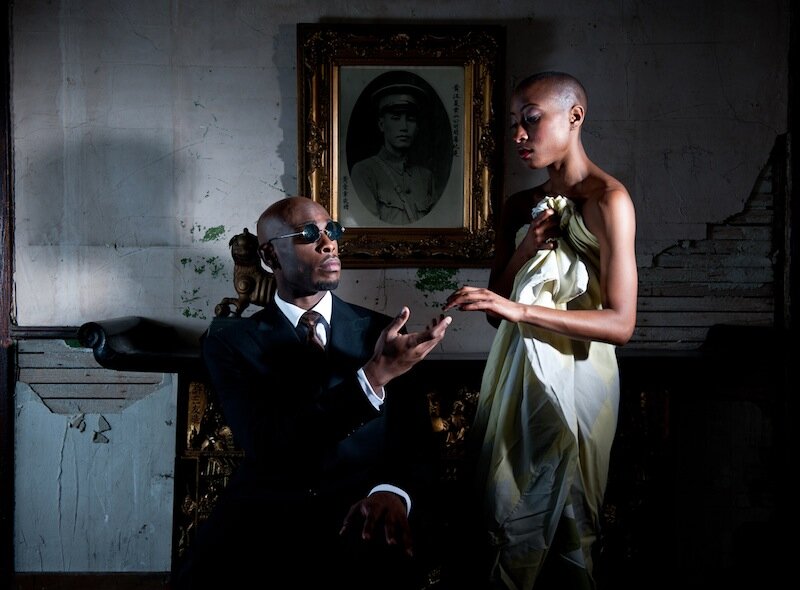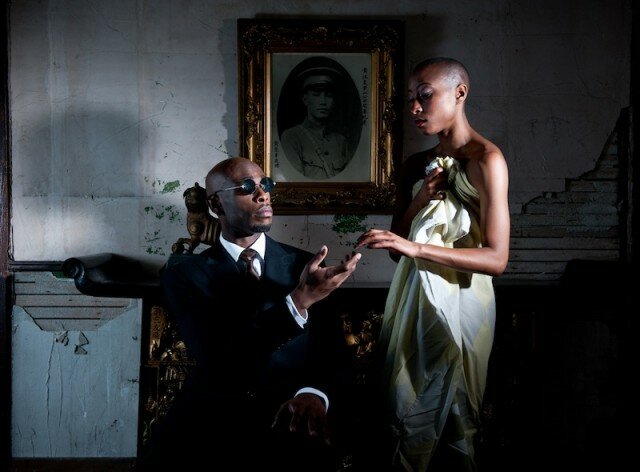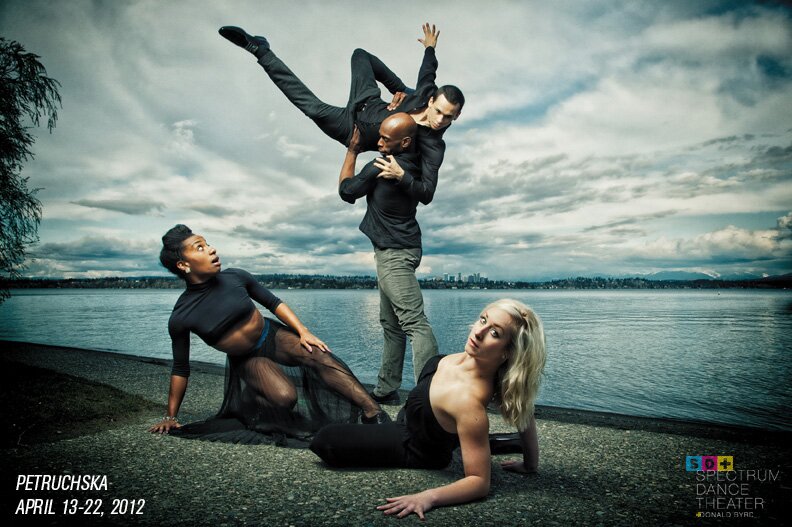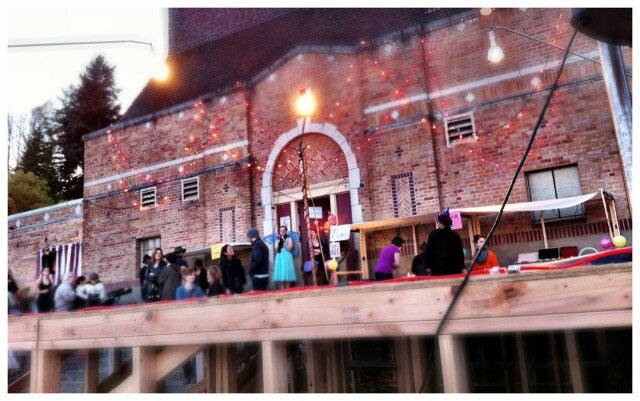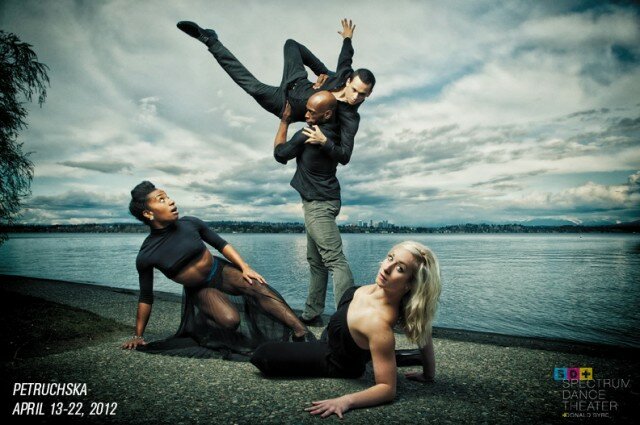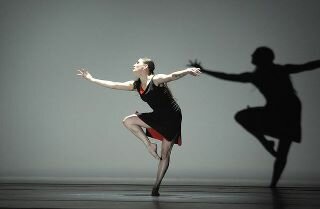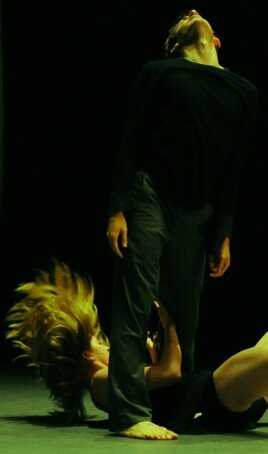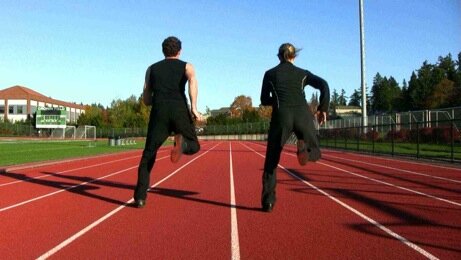I was made curious by our SunBreak review of Spectrum Dance Theater‘s last show of the season, LOVE. A world premiere from choreographer Donald Byrd, the work left our critic impressed but asking, “But what had this to do with love?” As it happens, a lot. Still, after trundling down to Daniels Recital Hall for the last performance, I could understand the bewilderment. Byrd’s choreography is almost always as heady as it is kinetic, but here he’d reached new heights, and folded in a sort of muscle-memoir besides.
At a pre-performance talk, Byrd had addressed the idea that it was “all about him,” saying more or less that while he’d drawn from personal experience, it wasn’t a danse à clef–that’s just the material he had to work with. While it does help, I think, to be familiar with Byrd’s biography in watching the piece, there other, jaw-dropping moments where the bravura physicality of Spectrum’s dancers is matched to an equally surprising conceptual pivot.
Keeping in mind, for instance, that Byrd is the bad-boy choreographer who thrust a heroin-addled Cobain jonesing for fix in an audience’s faces, it was unexpected to watch Rodin’s The Thinker appear off bias, or realize late in the evening that an allegorical Amor (in the breathtakingly limber form of Jade Solomon Curtis) had just flown in. In his Seattle Times review, Michael Upchurch describes the scene:
In the third suite, the degree of trust — a mix of abandon and utter self-control — that Jade Solomon Curtis displays in her fellow dancers is awing. With their help, she’s caught, propelled, flung, inverted and sent soaring, occupying the air as if it’s her natural element.
Byrd’s polysemous choreography embraces both a loveliness that catches in your throat, and supports a colder-eyed analysis; City Arts‘ Rachel Gallaher noted the way Curtis is “tossed, supported, lifted up and passed between the men in the company—perhaps a comment on male-controlled society or relationships….” Perhaps. If that is Amor up there, you’re also watching men in her thrall. Many things are true of this scene.
Poetry is thought by some a series of weak-minded, airy effusions, and bad poetry certainly can be. But the task of, say, a metaphysical poet is far too specific for someone with a feeble mental grip on the yoke they’re using to bind two things not normally bound. In the mind, they want to spring apart, back to their usual categorical associations.
In dance, similarly, Byrd is something of a metaphysical choreographer. Here we see Amor, but the metaphor is applied to the mechanics of movement: The dancers are, of necessity, as rapt as someone in love, focused intently on every move Curtis makes, every breath, even, that she takes. They have to be–otherwise she’d fall. Byrd’s choreography frequently uses the real risks of dance (falls, injury, missteps, awkward catches) to communicate an emotional reality, one that operates as a field you’ve unwittingly stepped into. So the risks of the dancers rhyme with those of the lovers.
In this way, Byrd can have his choreographic cake, and eat it, too: His vocabulary of abstract movement impresses with its internal coherence. Words don’t, descriptively, capture what’s going on, any more than “red and purple paint splatter” gives you an idea of what seeing a Pollock is like. But nonetheless you see things emerge between the dancers, the gestures they trade and react to. Whoever Ty Alexander Cheng and Shadou Mintrone are in this piece, it’s not because either has a name, or can easily be given a label, but you’re invested in their danced relationship and its discontinuities.
If there’s a narrative thread to LOVE, I think it’s in its furious attempt to make art from love, and more specifically, from love that’s gone missing. Set to Benjamin Britten’s three Cello Suites, played with an almost inhuman dynamic variety by Wendy Sutter, the work begins with the soulful Vincent Michael Lopez stepping into it–stepping through his clasped hands, a move he’ll repeat at the finish.
He’s the Stephen Hero of LOVE, someone whom we see formed both by his own relationships and by the ones he simply witnesses (Byrd has Lopez at one point run across the stage, staring into faces as if he’s trying to discern which is “the one” for him). He’s torn between a woman and a man with daimonic presence. Lopez all but shakes in his presence; Jeroboam Bozeman picks him up like a toy, arranges him into shapes, is maternally tender with a head on his breast. It’s a passionate meeting of minds (Byrd has the dancers touch foreheads repeatedly, as a kiss, as a benediction, as an epiphany that catapults one away). Lopez’s character flees, but his heart is clearly restless.
I can’t shake the feeling that it is not coincidence that people say they see more of Merce Cunningham’s choreographic influence in this work. In the mid-section of the evening-length dance, Byrd interpolates a Mercian twitching that would also suggest, having seen his Cobain, drug addiction–which also makes it, in this context, Byrdian. It’s in this part that the relational world blooms across the two bare stages, everyone partnering up, whether in ballroom dance attitudes (Cheng, Shadou) or sweaty beddings (Kate Monthy, Donald Jones, Jr.) or perhaps misplaced infatuations (Bozeman, Amber Nicole Mayberry). Feet are stamped. By the end, two of the women have seem to have had enough, and embrace each other.
It’s striking to me that the last cello suite quotes from the Russian Orthodox Hymn for the Dead. It’s here that Amor appears, transcendent, but also vanishes, and in her wake, so does Bozeman. Lopez, bereft, retraces his steps from the opening. Daniels Hall used to be a church, and I watched the dance take place beneath the nave, stained glass in the dome glowing with sunset. With the hymn in my ears, I found it impossible not to think, again, of Cunningham’s death in 2009. In love, you’re out on a sea of emotion; when someone dies, it’s suddenly a ship in a bottle. How could that immense experience fit into time, have an end?
I take Byrd’s cue not to read LOVE as autobiography, but as a story about the kind of titanic love that, if you are blessed and cursed in equal measure, comes along just once in a life. And leaves, even years later, with as great an impact as it arrived.
